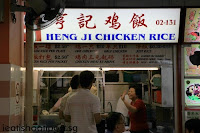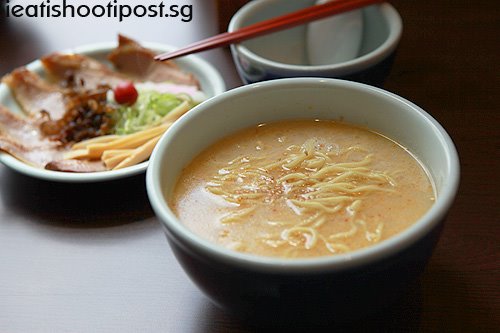Rakuichi Japanese Restaurant: I am now truly a Sashimi Convert!
On Commercial Shoot with PowerAunty and gang
Appetizer: Sardine sheet, pitan tofu, river shrimp, semi-grilled tuna belly, yam $12.50
It's not everyday that you get to eat a $200 per head meal. The last time I did it was in Tokyo, but that was when I fulfilled a life's dream of eating Matsuzaka beef. For guys without a corporate account like myself, spending $200 on a meal requires a good excuse or in the case of Rakuichi, a blessing.
PowerAunty had invited me along for a commercial shoot at Rakuichi Japanese Restaurant. Her friend, the owner of the restaurant had asked her to help gather some calefare to star in a video commercial they are shooting. With us that day was Chef Tom Kondo who is a Japanese Chef. So I had a Japanese Japanese (sic) expert on hand to tell me about the exquisite dishes we had that day.
You will get to meet Chef Tom later on in the blog as we have been shooting a series of Video Blogs where I will be accompanying Chef Tom to the Japanese Supermarket to buy groceries. He will be showing us how to choose the different Japanese sauces and ingredients and then show us some simple Japanese recipes which you can also cook at home. That is "Akan Datang" (coming soon), so this is just a teaser.
When PowerAunty invited me for this lunch, I had no idea it was going to be a showcase of the best that Rakuichi had to offer and we only really found out the actual value of the meal afterwards. But don't be taken aback, Rakuichi is one of those places where you can order a Bento box from as low as $18 to a meal as high as the sky if you want.
Japanese food is always a joy to photograph (the worst is rojak) and even more so at Rakuichi where there seems to be quite an emphasis on immaculate presentation. The appetizer was a work of art and I would admit that I enjoyed it more with my eyes then I did with my tongue. But that is not to say it is not good. It is just that the presentation of the sardine sheet (small little deep fried fish) arching over little river prawns was such a delight to look at that I derived more enjoyment photographing it than actually eating it. But as an appetizer, it really does fire your anticipation of what is coming next. 4.25/5 
Sashimi Boat: Botan prawn and sea urchin shown $466 for 6 persons
The bulk of the price of this $200 meal lies with this Sashimi boat. I have been slowly developing my interest in Sashimi and after this particular meal, I would say that I am truly a convert. Really good quality Sashimi is divine and I realise that the reason I did not like Sashimi before was because I hadn't eaten the good ones. This is the best Sashimi I have come across. I know it is not cheap but you really can't get quality unless you pay for it.
The Uni (Sea Urchin) is served in its shell and the icy cold roe is an absolutely dream to eat. We simply wrapped a bit of it in seaweed, add a bit of cucumber, fresh wasabi and sesame seeds. It was the sweetest, freshest Uni I ever had. 4.8/5
Otoro: Tuna Belly
The rest of the items on the boat were similarly excellent including the scallops and ark shell which are currently in season. Then of course there is the Otoro (Tuna Belly) which was served in big generous slabs, beautifully pink and chilled. I was however a little confused about the pattern of marbling on the Otoro. The Otoro I had in the past all had a more intricate reticular marbling pattern. So my first impression of this "Otoro" was that it was "Chutoro" instead. Chutoro, as you know, is the part between the actual belly (Otoro) and the flesh (Akami). It is not as fat as Otoro. Perhaps our Sashimi experts can enlighten us? 4.5/5
Fresh wasabi on sharkskin board
There are some people who prefer processed Wasabi because it tends to be spicier. But I prefer the fresh version because it adds the taste of Wasabi without too much heat and the slightly fibrous texture is a nice contrast to the smooth flesh of the fish. As Japanese food continues to enjoy its growing popularity in Singapore, we will be seeing more of these fresh Wasabi around.
Deep fried prawn and vegetable $12.60
I included this picture of the deep fried prawn because I think it is a nice photo, but I am partial to this prawn wrapped in beehoon. Still prefer tempura style prawn. 3.5/5
Grilled skewer set: Fish belly with leek, eggplant miso, gingo nuts, pork belly, mushroom wrapped with bacon, mushroom with minced chicken: $36
The other dish I would highly recommend is the grilled skewer set. In particular the grilled pork belly is fabulous. This is actually Yakibuta which is pork belly which has been braised first before grilling. The seasoning is excellent though the pork was just slightly dry. Still, it was quite memorable. 4.25/5. Ironically, I derived the most enjoyment from a non-meat item. The eggplant with miso was perfectly balanced. Soft on the inside, charred, sweet and smoky on the outside, it's a vegetarian dish which any carnivore would be more than happy to eat. 4.5/5
Grilled Ayu (Sweetfish) with salt: $16
I had seen this Ayu (Sweetfish) before, live, the last time I was in Tokyo. It looked a little bit like a miniture trout (when it was alive) and I know it is a favourite among the Japanese. This seasonal fish can be found in the rivers of Japan and is often eaten simply grilled with salt. It is said that the flesh is sweet, hinting of flavour of melons and cucumber. It was interesting for me. I found the flesh very fine but I think I should have eaten it freshly out from the grill because it was a bit dry after I finished with the photography. Trust the Japanese to be able to make you pay $16 for it. I don't think we will ever be able to get the Japanese to pay $16 for Ikan Kuning. 4/5
Simmered Kinki (red eye fish) $146
This is the first time that I am eating Kinki. When it comes to steamed fish, I think we are most accustomed to the usual Coral Trout, Parrot fish, Seabass that is served Cantonese style. So this Japanese style simmered Kinki was really something quite novel. This fish was really fresh and the flesh was so delicate and smooth that it just dissolves in the mouth. Not cheap, but very good. 4.5/5
Gindara Bento Set $46.60
The meal I had was so good that I had to go back a second time the following week to try their Bento sets which are quite good value. This return trip was more modest but the food was still excellent. The Gindara Bento is one of the more expensive sets but as you can see in the picture, you get, amongst other things, a whole tray of sushi and sashimi accompanied by teapot soup, prawn and vegetable tempura, gindara teriyaki, salmon eggs and deep fried river prawns. If you have a few friends, it is just a matter of ordering a few of these sets to share around and you will get to try a lot of different things. The prices start from $18 and they have quite a few interesting sets in the $20 - $40 price range.
Rainbow Set $36.60
I would highly recommend the Rainbow Set. Actually, this was highly recommended to me by PowerAunty and I think you can see why when you look at the photo. The visual and gustatory appeal of this set is well balanced. This one is not just eye candy. Besides looking good, you will derive a lot of pleasure from savouring the different types of Aburi (torched) Sushi as well as a plate of fresh sashimi.
Conclusion
There are many segments in the Japanese restaurant industry. You have the low cost sushi trains found in shopping centres and the high end Japanese restaurants found in 5 star hotels. Rakuichi falls somewhere in the upper range in terms of quality but mid to upper range in terms of price. I think it is a place where you can get your quality at quite a reasonable price.
But don't just take it from me. Chef Tom is a regular here and according to him, this place sells the freshest sashimi at prices which are not inflated like elsewhere. Definitely worth a visit for lovers of Japanese food.
Special for ieatishootipost readers
Mention ieatishootipost and get 10% off the total bill.
(Cannot be used with other credit card promotions) Rakuichi
Rakuichi
Blk 10 Dempsey Road #01-22
(Near Jones the Grocer)
64742143
www.rakuichi.com.sg












































